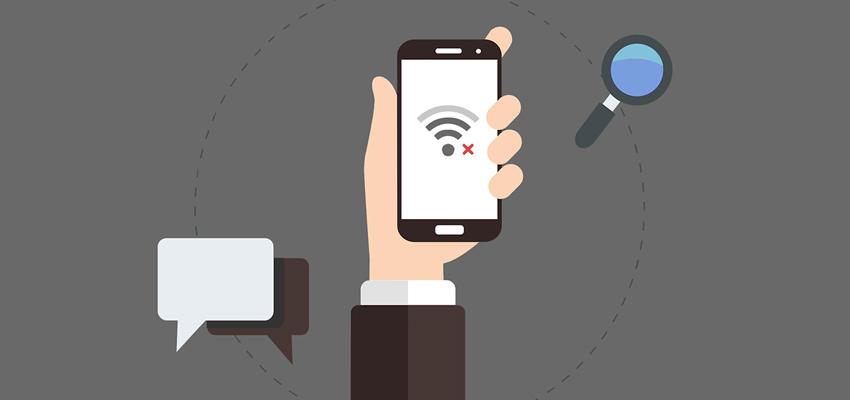
Why Do Wi-Fi Connections Drop?
Posted April 5, 2020, 9:08 a.m. by Emil S.There are numerous reasons why your Wi-Fi connections get a weak signal all of a sudden, the connection drops off, or you may even lose the connection for a while. Here is a list of some of the most common reasons why Wi-Fi connections drop and the solutions that you can do to fix it.
Network Issues
The first thing you should check if your Internet connection is unstable is your Internet service provider. If the problem is coming from their end, all the tinkering you do from your end will have no use. So, make sure to check from your Internet service provider first. Their technical support can run the system and line checks to see if there are any issues from their end. They can also help you when it comes to troubleshooting to fix the connection.
Poor Network Range and Power
Sometimes, you lose your Wi-Fi connection because you are somewhere in the outer edges of your router's or modem's range. The farther you are away from your router or modem, the more chances your Wi-Fi connection will be interrupted.
This is why the location of your router or modem is key. It is best to place it in the central area of your home so that most rooms will be within its network range. Do not place your router or modem in the basement, in a closet, or a place surrounded by thick walls and other obstacles. These could be blocking your signal and will prevent you from getting a good Wi-Fi connection.
You can also simply just move closer to the router when you are online. The lesser the distance, the stronger the connection. This is very easy if you are going online using a wireless device like your tablet or smartphone. As for your personal computer or laptops, you might consider moving your desks or workstations nearer to where the router or modem is located.
If you have done all this and your Wi-Fi connection still drops, you should check if there is something wrong with your router or modem. It may be an old model and needs to be replaced. Or it could be experiencing technical errors that need to be repaired.
Another way to enhance the strength and range of your Wi-Fi connection is to get an antenna upgrade for your personal computer or the router. There are range extenders and mesh networks available in the market to help you fix these problems.
Radio Interference
You have a lot of electronic products and appliances in your home and the radio signals from them can sometimes interfere with the network signals of your Wi-Fi when these appliances or products are being used. Examples of these appliances include automated garage door openers, Bluetooth devices, cordless phones, and the microwave.
To fix this, do not go online near these appliances. It is also best if you move your router or modem and other network equipment far away from these items as well. You also have the option to change your Wi-Fi radio settings to avoid interference.
Overloaded Network

If there are too many devices using your home network, this will divide up the Bandwidth available and place a limit on how much data each device can use.
When the assigned bandwidth is stretched too thin, videos stop loading and websites cannot be accessed. Sometimes, your device will eventually give up and get out of the network to try to reconnect to it again and this process will keep on going until it gets enough bandwidth to access the Internet.
The obvious solution is to take off some devices from the network. Turn off the Wi-Fi for devices that are not being used. If someone in the house is playing online games all day, ask them to take a break. If someone needs to download heavy files, ask them to use a program that has bandwidth control so that they consume less bandwidth while downloading the file.
With this, Microsoft OneDrive tends to eat up a lot of your upload bandwidth when syncing heavy files so if you are using this, you should not use it when most of your housemates are using the Internet. If your network is still slow or the Wi-Fi is still not stable despite asking everyone to get off the net for a while, you should restart your router. The router's memory may be full and restarting the device will flush it out and help it refresh.
Your Internet plan promised you a number when it comes to Internet speed. You should test your Internet speed to see if you are getting what you are paying for. If the results show a significant decrease in speed, there may be a problem with your router or modem or there are too many devices accessing the network at the same time.
Faulty Router
If you find yourself always restarting your router, it may need to be replaced or repaired. Contact your Internet service provider to request for a new model. They may be able to replace your router free of charge. You also have the option to get a new router yourself so you can have more features or have more Ethernet ports. Just make sure that the router you get is compatible with your Internet service provider.
Overheated Modem
If you are experiencing an unstable connection, you should also check your modem if it feels hot. When a modem overheats, this can cause instability in your Internet connection. When this happens, turn off the modem and give it time to cool down. After, turn it on again and test your Internet connection. If it is more stable after the cooldown, you need to find a way to keep your modem cool or replace it.
You Connected to a Different Network
Sometimes your Wi-Fi connections drop simply because you are using the wrong network. This happens if there are two neighboring locations with the same SSID. You may be misdirected to the other Wi-Fi network without your knowledge.
If your connection is misdirected to another network, you will lose connection when their router is off and will be experiencing problems when that network has bandwidth problems. If their network is so open, there is a huge chance that other neighbors are connected to it too so the network may be overloaded as well.
To avoid this from happening, set up your devices to stop joining available networks in your area automatically. This will prevent your device from picking up an unsecured Wi-Fi connection as well. If you know who owns the open network among your neighbors, it would be kind and wise to tell them that anyone can access their Wi-Fi and advise them to set up a password so that they get their money's worth and people will not leech on to their connection.
Missing or Outdated Firmware or Driver
Every computer that uses a Wi-Fi network has a device driver software. Wi-Fi routers have the same technology known as firmware. Over time, this software can be obsolete or corrupted. When this happens, this can cause wireless problems, causing your Wi-Fi connection to drop.
When your Wi-Fi problems are caused by this, all you have to do is update and upgrade. For network drivers, you should update to the latest available version. You know you need to do this if your Windows keeps on disconnecting from the network. For routers, you should upgrade the firmware to the latest available version.
Software installed Is Incompatible
This type of problem rarely happens but sometimes your computer fails to connect to the Internet because it has incompatible software installed in it. This can include services and patches that affect the networking capacities of the operating system.
You might have this problem if your Wi-Fi connection drops after you did a software update or installed new software. When this happens, you may have to uninstall the incompatible software. If you tried this and the problem persists you should consider reinstalling your operating system but only do this as a last resort.
For your phones, you can also reset your Android and iPhone to their factory defaults if you think you are experiencing a software problem. Now that you know the most common reasons why your Wi-Fi connection is unstable, you can easily fix the situation with the tips above to continue streaming, working, and gaming with no hassle.
